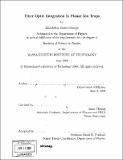Fiber optic integration in planar ion traps
Author(s)
George, Elizabeth Marie
DownloadFull printable version (19.90Mb)
Other Contributors
Massachusetts Institute of Technology. Dept. of Physics.
Advisor
Isaac Chuang.
Terms of use
Metadata
Show full item recordAbstract
Atomic ion traps are are excellent tools in atomic physics for studying single ions. Accurate measurement of the ion's electronic state in these ion traps is required by both atomic clocks and quantum computation. Quantum computation with trapped ions can only scale to larger numbers of qubits if the ion traps and their laser delivery and measurement infrastructure can be scaled to smaller sizes. Fiber optics are a promising method of measurement because they collect a large fraction of light scattered by the trapped ions, and many optical fibers can be placed in a small area, allowing more ions to be measured in a small region. The question I address in this thesis is, "How can optical fibers be integrated onto planar ion traps?" This thesis presents a process I designed and implemented for integrating optical fibers onto planar ion traps as well as a system for integrating optical fibers into a cryogenic system. While the fiber integration was successful, we were unable to trap any ions in our fiber-integrated ion trap. We were able to show that the integrated fiber could collect light scattered from the surface of ion trap, and hypothesize that the large amount of dielectric present on the surface of the trap may have distorted the trapping potential and prevented us from trapping any ions. We also determined that scatter spots on the surface of the trap are a much bigger problem for fiber optic light collection systems than for traditional bulk optics systems. Finally, we propose a method of integration that could reduce the amount of exposed dielectric in the vicinity of the trap, as well as solve the problem of sensitivity to scatter spots.
Description
Thesis (S.B.)--Massachusetts Institute of Technology, Dept. of Physics, 2008. Includes bibliographical references (leaves 69-70).
Date issued
2008Department
Massachusetts Institute of Technology. Department of PhysicsPublisher
Massachusetts Institute of Technology
Keywords
Physics.